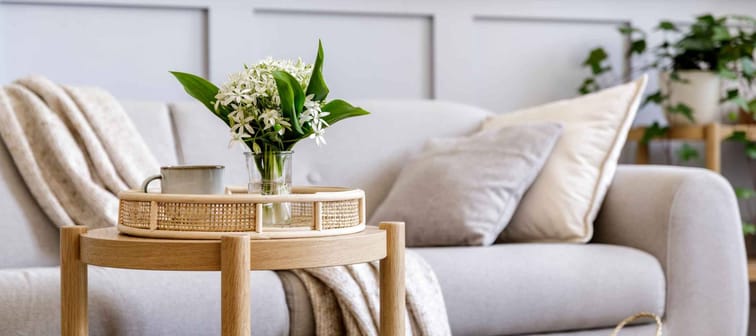What is home staging?
Staging your home isn’t just about re-decorating. Whereas decorating is tailored to your personal taste, staging is about preparing your house for a sale.
“Home staging is the process of outfitting a home with furniture and accessories and related home improvements to bring out the best features of your home,” says Nicole Babb, a professional stager with Rich and Poor Home in Toronto. “Usually, the process of home staging involves emptying your house of clutter/old furniture and replacing it with newer or themed furniture and accessories. It sometimes can also include a new paint job, new flooring or new kitchen depending on your budget.”
Home stagers are more than designers: they’re trained pros who understand what it takes to stage your home to sell.
Why stage your home?
You wouldn’t go to a job interview dressed in ripped jeans and a grotty t-shirt, right? The same applies to selling your home: You want to make the best first impression possible to attract buyers. According to a report by BMO Financial Group on the “Psychology of House Hunting,” 80% of prospective buyers know if a home is right for them within the first few seconds of stepping inside. Essentially, you’ve got one shot to capture a buyer’s attention—so get it right.
“When shopping for a home, most people find it difficult to envision how they would utilize a room/space to best suit their needs,” says Babb. “Staging provides that extra ‘umph’ to direct the buyer’s imagination and assist with showcasing the best assets of the home you’re selling.”
Plus, research shows that home staging works. A study by the Real Estate Staging Association looked at 1,081 homes and found that un-staged homes spend an average of 184 days on the market. After staging, these homes sold on average in 41 days. In contrast, homes that were staged from the get-go sold on average in 23 days, spending 90% less time on the market.
Remember, if your house sits on the market for more than two weeks, a price reduction of 2% or more is typically recommended. That means that if your house is priced at $500,000, it would be reduced by $10,000 to $490,000. If the property still doesn’t sell in another two weeks, the listing price may drop again to $480,000. That’s $20,000 (or more) lost within four weeks. Ultimately, an un-staged, stale property may sell for well below the list price, particularly if you get low-ball offers.
Another consideration: home staging can actually push up the selling price of your home. Experts estimate that staging a home can deliver a price that is 6 to 20% more than a non-staged home. For example, if you’re selling for $500,000 and stage your home for $5,000, it might attract multiple offers and trigger a sale above the asking price. So you may recoup that $5,000 spent to revamp your abode.
House staging cost
What’s the size of the space? Is the property vacant or occupied? Do you need to store your stuff? The cost of home staging depends on many factors.
According to Babb, expect to pay roughly $2000+ to stage a space that’s less than 1000 square feet. For homes larger than 1000 square feet, it generally works out to $3000+. Here’s a breakdown of staging cost variables:
- Size: The larger the space, the bigger the bill. “Square footage of a home is a major factor,” says Babb.
- The room: Certain rooms will cost more to stage because they require more finishing touches. For instance, a bedroom needs everything from bedding to artwork to lighting, whereas a bathroom may only need a few fancy towels and accent pieces to make it presentable.
- Vacancy: “If there’s furniture already in the home that can be used to stage, that’s also a consideration,” says Babb. An empty apartment usually requires bringing in more furniture and accents, adding more numbers to the final bill.
- Storage: Do you need to put stuff in storage? Tack on the price of a moving company and storage unit to your final bill.
You could stage one or two rooms if you’re on a tight budget, although it may look odd if half your house is impeccably dressed and the other half looks “lived in” or outdated. If you choose to semi-stage, Babb recommends prioritizing the kitchen, living areas, and bedrooms to maximize your return on investment.
Tips for staging your home
There are some simple, affordable tricks of the trade to transform your humble home into a stylish sanctuary. Essential staging tips from the experts at Rich and Poor Home include:
- Paint: “Painting can be a very cost-effective way to give your home a quick face lift.”
- Bedding: “Use new bedding for your bedrooms – crisp sheets, fluffy duvet covers, and firm pillows can turn any boring bed into a hotel-like bed.”
- Declutter: “Can’t stress it enough, clear all your clutter! Removing items from any countertop can open up a space in 60 seconds. Make sure your home and surrounding areas are clean and free from debris.”
- Choose calming colours: “Keep the colour palette of your space neutral. No loud or distracting colours.”
- Keep it a scent-free zone: “Don’t use strong air fragrances or candles. Strong scents can irritate the senses and you don’t want to distract the buyer.”
- Hire help: “Go with a reputable stager – one with a portfolio and reviews. Have the preliminary consultation done. This will allow you to communicate with your stager about your needs and how best to achieve them.”
How to finance home staging
We get it: drumming up a few thousand dollars when you’re in the middle of selling your home might seem impossible. Luckily, there are lots of ways you can finance this expense if you’re short on cash:
Line of Credit
An LOC is an open-ended loan that allows you to borrow money at any time, up to a specified limit. The interest rates tend to be lower than a credit card and there’s no set schedule of repayments – giving you the ultimate flexibility. You may also be able to score a preferred interest rate from your lender if you take out a secured or home equity LOC.
Personal loan
A personal loan will usually have a lower interest rate than a credit card, and has a set repayment schedule over a specified period of time (usually 1-5 years). Take the time to research and shop around to get the best loan interest rate possible.
Credit card
Charging your home staging costs onto your credit card can maximize your rewards earnings or net some serious cash back. But remember to pay off the balance ASAP, as the interest can be 18% or more. If you can’t pay the bill right away, consider transferring the balance to a card with 0% interest.
Ask for a payment plan
If you don’t have the dough up front, ask your stager if they can offer a payment plan. How it works: agree upon a payment schedule with your stager and give them post-dated cheques. Then set up direct deposit of your paycheque into your chequing account to ensure that you’ll always have enough to cover the installments.






